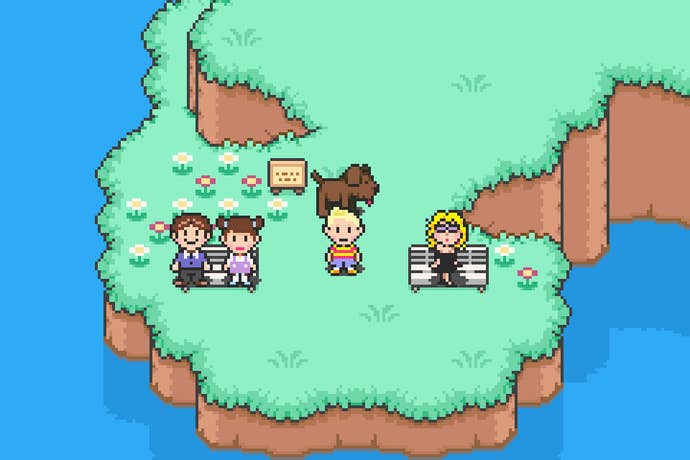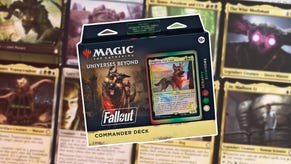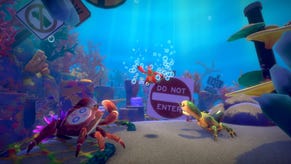True Tales from Localization Hell
COVER STORY: Three veterans of video game translation recount their most harrowing projects.
This article first appeared on USgamer, a partner publication of VG247. Some content, such as this article, has been migrated to VG247 for posterity after USgamer's closure - but it has not been edited or further vetted by the VG247 team.
Clyde Mandelin
Unlike the other localizers featured in this cover story, Clyde Mandelin began his career in a much different place: the fan translation scene. During the "emulation boom" of the late '90s/early '00s, Mandelin embraced this emerging technology by translating Japanese games that never made it to America. Thanks to Mandelin (and some of his helpful hobbyist friends), we now have playable English versions of RPGs like Live-A-Live, Bahamut Lagoon, and Star Ocean, as well as other oddities like Famicom Detective Club Part II.
Mandelin would soon take his localization skills to the anime scene, translating notable titles like One Piece, Lupin the 3rd, Dragon Ball, and Detective Conan, but fanatic EarthBound devotees know him best for heading up the fan translation of Mother 3. While several translation groups took a stab at converting this long-awaited game into English, Clyde's team actually completed this monumental task in October 2008, resulting in a finished product that remains incredibly faithful to the flavor and quality Nintendo established with their EarthBound localization back in 1995.
USgamer: So, let’s talk about Mother 3. What went into making this game possible to play in English, and how long did you put it off, just out of fear of all the work that would have to go into it?
Clyde Mandelin: So, it got released in Japan in—what was it—April of 2006, and for the longest time I didn’t want to work on it, because I knew it was a whole lot of work. And the day it came out, people were sort of expecting zero-day translations of it, which was like, pretty ridiculous, but I can understand, because people didn’t know at the time.
USg: What was the timeline like for this project?
CM: So, we had a couple contacts inside Nintendo, and it was sort of like a two-pronged approach. First, we were going to contact all the different media and get them to talk about Mother 3, and maybe that would help spread hype about it. We also had some contacts inside Nintendo, and we knew there was going to be a meeting about whether or not they should do it.
We knew who was involved. So, we were going to try to use our contacts to go in there and show them all this data and show them how many people are interested nowadays, how much it would cost. It was a whole bunch of numbers and stuff like that, and we prepared all that... So, there was that, and we didn’t really hear anything back until the end of the year when there were some rumblings from [Nintendo's localization division] Treehouse about how we’re not planning to work on it, so, "Go get your Ness on in Smash," or something. It got people really angry. That’s when we decided that we were going to pool a bunch of the talents from the community to make our own patch. That was November, December 2006 when we decided that we were going to start.
USg: So, what were the steps involved initially in actually dumping the text, figuring out how to approach it?
CM: It’s a lot easier nowadays, now that everything’s sort of in a file system, like, with the start of the DS and PSP, a lot of disk-based systems. But with Game Boy Advance and earlier, everything is just a big blob of data. So, when you dump a [game] cartridge, you just get a whole bunch of 1s and 0s, you don’t know where anything is. So you have to go and use tools to sift through it all and find it all.
And after that comes the hard part. Sometimes [the text is] compressed, sometimes it’s encrypted... From what I recall, Mother 3’s text data is not compressed, because it’s already a big cartridge, at the time. I don’t think it was encoded in any way. But you couldn’t open up a text editor and start plugging away at it; you had to extract the data, so we did that. And that involves extracting the script text, which is usually the hardest part, because there’s so much text involved. There’s items, enemies, item descriptions, and then there’s just weird, weird side text that you don’t expect, like, during cutscenes and things like that. So, there’s all kinds of little pieces of text you have to go and dig around in and document.
USg: Did you have to make more room for the English text, given how English text takes up a lot more space than Japanese text? Did you have to expand the word boxes? How did that work exactly?
CM: We had that problem, and the Mother 3 ROM is already the maximum size for a Game Boy Advance cartridge. You can’t expand the ROM or anything like that. So, we had to do some creative solutions. One involved rearranging the game’s own data, like Tetris, arrange it nicely to open up some room for us. We did some strange compression. It was some pretty interesting stuff, and it kind of just barely fit when all was said and done.

USg: So, what was your role in the project, and what was your general timeline for this?
CM: We started probably in June 2007-ish, and then we released in October of the next year. For the most part it was just me and one other person, his name was Jeff. Together we are both, sort of like the founders of the EarthBound hacking community, so we sort of have experience hacking EarthBound games. We kind of already had that teamwork going, so we just dived right into it. So, both of us did the programming. He did a lot of the tools, that really sped up everything.
It probably would have taken an extra year without his tools. I did pretty much most of the translation, and then a friend of mine who works for Fangamer and works for [Mother series creator/writer] Shigesato Itoi did some of the item names, the enemy descriptions, stuff like that. Sort of like the secondary text. So, basically, it was us three, we were the core of the team. People would come and go. If we were to run into a problem, we would ask someone for help, or someone would show up to help, and they would just disappear a day later. So, I guess altogether we had maybe 15 people, if you want to count them as part of the team.








